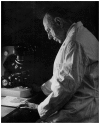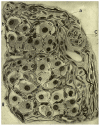Fernando de Castro and the discovery of the arterial chemoreceptors
- PMID: 24860435
- PMCID: PMC4026738
- DOI: 10.3389/fnana.2014.00025
Fernando de Castro and the discovery of the arterial chemoreceptors
Abstract
When de Castro entered the carotid body (CB) field, the organ was considered to be a small autonomic ganglion, a gland, a glomus or glomerulus, or a paraganglion. In his 1928 paper, de Castro concluded: "In sum, the Glomus caroticum is innervated by centripetal fibers, whose trophic centers are located in the sensory ganglia of the glossopharyngeal, and not by centrifugal [efferent] or secretomotor fibers as is the case for glands; these are precisely the facts which lead to suppose that the Glomus caroticum is a sensory organ." A few pages down, de Castro wrote: "The Glomus represents an organ with multiple receptors furnished with specialized receptor cells like those of other sensory organs [taste buds?]…As a plausible hypothesis we propose that the Glomus caroticum represents a sensory organ, at present the only one in its kind, dedicated to capture certain qualitative variations in the composition of blood, a function that, possibly by a reflex mechanism would have an effect on the functional activity of other organs… Therefore, the sensory fiber would not be directly stimulated by blood, but via the intermediation of the epithelial cells of the organ, which, as their structure suggests, possess a secretory function which would participate in the stimulation of the centripetal fibers." In our article we will recreate the experiments that allowed Fernando de Castro to reach this first conclusion. Also, we will scrutinize the natural endowments and the scientific knowledge that drove de Castro to make the triple hypotheses: the CB as chemoreceptor (variations in blood composition), as a secondary sensory receptor which functioning involves a chemical synapse, and as a center, origin of systemic reflexes. After a brief account of the systemic reflex effects resulting from the CB stimulation, we will complete our article with a general view of the cellular-molecular mechanisms currently thought to be involved in the functioning of this arterial chemoreceptor.
Keywords: Fernando de Castro; arterial chemoreceptorss; carotid body; ion channels; sensory physiology; transduction cascade.
Figures







Similar articles
-
Towards the sensory nature of the carotid body: hering, de castro and heymansdagger.Front Neuroanat. 2009 Dec 7;3:23. doi: 10.3389/neuro.05.023.2009. eCollection 2009. Front Neuroanat. 2009. PMID: 20057927 Free PMC article.
-
The discovery of sensory nature of the carotid bodies--invited article.Adv Exp Med Biol. 2009;648:1-18. doi: 10.1007/978-90-481-2259-2_1. Adv Exp Med Biol. 2009. PMID: 19536460
-
Fernando de Castro: Cajal's Man on the Peripheral Nervous System.Anat Rec (Hoboken). 2020 May;303(5):1206-1214. doi: 10.1002/ar.24191. Epub 2019 Jun 20. Anat Rec (Hoboken). 2020. PMID: 31172650
-
The Cajal School in the Peripheral Nervous System: The Transcendent Contributions of Fernando de Castro on the Microscopic Structure of Sensory and Autonomic Motor Ganglia.Front Neuroanat. 2016 Apr 20;10:43. doi: 10.3389/fnana.2016.00043. eCollection 2016. Front Neuroanat. 2016. PMID: 27147984 Free PMC article. Review.
-
Sensory Processing and Integration at the Carotid Body Tripartite Synapse: Neurotransmitter Functions and Effects of Chronic Hypoxia.Front Physiol. 2018 Mar 16;9:225. doi: 10.3389/fphys.2018.00225. eCollection 2018. Front Physiol. 2018. PMID: 29615922 Free PMC article. Review.
Cited by
-
Vasoactive Intestinal Polypeptide in the Carotid Body-A History of Forty Years of Research. A Mini Review.Int J Mol Sci. 2020 Jun 30;21(13):4692. doi: 10.3390/ijms21134692. Int J Mol Sci. 2020. PMID: 32630153 Free PMC article. Review.
-
Not Only COVID-19: Involvement of Multiple Chemosensory Systems in Human Diseases.Front Neural Circuits. 2022 Apr 25;16:862005. doi: 10.3389/fncir.2022.862005. eCollection 2022. Front Neural Circuits. 2022. PMID: 35547642 Free PMC article. Review.
-
Cajal and the Spanish Neurological School: Neuroscience Would Have Been a Different Story Without Them.Front Cell Neurosci. 2019 May 24;13:187. doi: 10.3389/fncel.2019.00187. eCollection 2019. Front Cell Neurosci. 2019. PMID: 31178695 Free PMC article. Review.
-
Oxygen, gastrin-releasing Peptide, and pediatric lung disease: life in the balance.Front Pediatr. 2014 Jul 18;2:72. doi: 10.3389/fped.2014.00072. eCollection 2014. Front Pediatr. 2014. PMID: 25101250 Free PMC article. Review.
-
Comparative exploration of the carotid body in domestic animals: morphology, physiology, histology, and pathology.Front Vet Sci. 2024 Nov 22;11:1409701. doi: 10.3389/fvets.2024.1409701. eCollection 2024. Front Vet Sci. 2024. PMID: 39649680 Free PMC article. Review.
References
-
- Adams W. E. (1958). The Comparative Morphology of the CB and Carotid Simus. Springfield, IL: Charles C. Thomas Publisher
-
- Almaraz L., Wang Z. Z., Dinger B., Fidone S. (1997). “Neurotransmitter mediation of carotid chemoreceptor efferent inhibition,” in The Carotid Body Chemoreceptors ed.Gonzalez C. (New York: Springer-Verlag; ) 47–158
Publication types
LinkOut - more resources
Full Text Sources
Other Literature Sources
Research Materials

